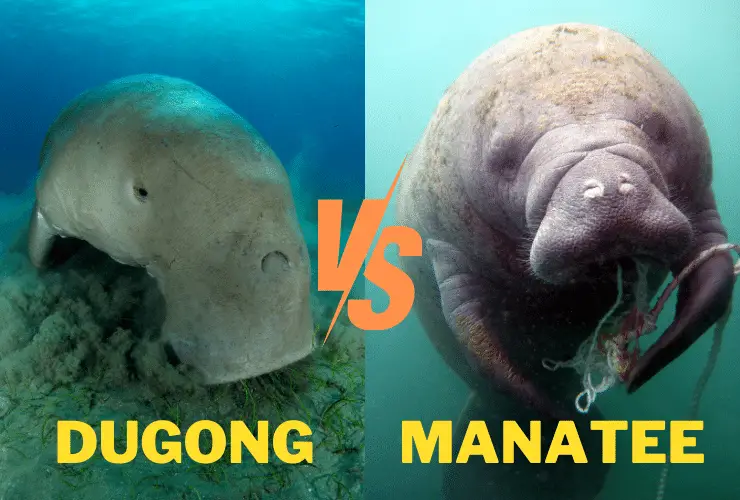The Dugong and Manatee are fascinating marine mammals, often confused due to their similar appearances. However, a closer look reveals key differences.
Dugongs have fluke-like tails similar to a whale’s, while manatees have paddle-shaped tails. Dugongs’ nostrils are located further back on their heads, whereas manatees have theirs near the tip of their snouts. They also have a different diet, with Dugongs primarily grazing on seagrass and Manatees having a more varied diet, including freshwater vegetation.
But hold on. There’s more! Although both belong to the order Sirenia, their distinct characteristics, lifestyles, and habitats make for an interesting comparison. These gentle, slow-moving creatures, known for their serene disposition and the mythical tales they inspire, capture the hearts of marine biologists and ocean enthusiasts alike.
Join us as we explore the unique worlds of the Dugong and the Manatee, uncovering the remarkable differences between these seemingly similar species. Believe us – there’s a vast ocean of differences to dive into!
Dugong Vs Manatee – A Quick Comparison Table
Let’s take a quick look at the differences between these two creatures.
| Feature | Dugong | Manatee |
| Scientific name | Dugong dugon | Trichechus spp. |
| Family | Dugongidae | Trichechidae |
| Body Shape | Streamlined, dolphin-like body | Rounded, paddle-shaped body |
| Tail shape | Fluked, crescent-shaped tail similar to a whale’s | Horizontal, paddle-shaped tail |
| Snout Shape | Tapered, broad, downward-facing, short snout with a slit | Shorter, flat, upward-facing snout |
| Teeth | Two tusk-like incisors in males, not visible in females | No visible teeth but have “marching molars” that constantly move forward as they wear |
| Size | Up to 11 feet long, weighing up to 400 kg | Up to 15 feet long, weighing up to 550 kg |
| Diet | Mainly seagrass | A varied diet, including seagrass, other aquatic plants, and algae |
| Habitat | Indo-Pacific regions, warm coastal waters | Shallow coastal areas, rivers, and estuaries in the Atlantic Ocean |
| Social Behavior | Very social, form groups of 2-100 individuals | Solitary, interact with females in estrus |
| Lifespan | Up to 73 years | Up to 60 years |
| Gestation period | About 14 months, a single calf born | About 12-14 months, a single calf born |
| Conservation status | Vulnerable | Vulnerable |
| Common names | Sea cow, sea pig, and sea camel | Sea cow |
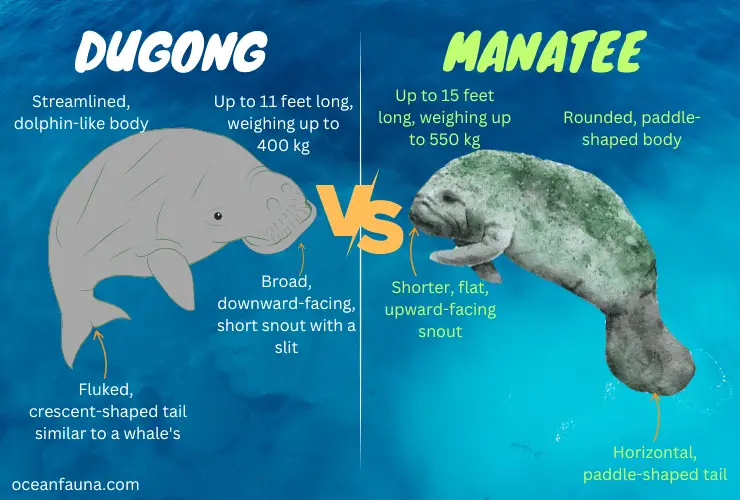
Dugong Vs. Manatee – What Are The Key Differences?
Dugongs and manatees are both aquatic mammals belonging to the Sirenia order. While they both have similar body structures and share a herbivorous diet, they exhibit notable differences that distinguish them. Let’s dive deep into the ocean’s expanse and explore who’s who in the world of marine giants.
1. Taxonomy and Classification
Despite their similar appearances, dugongs and manatees actually belong to two different families within the order Sirenia.
Dugong
Dugongs are part of the Dugongidae family and the only existent species of the genus Dugong. According to the Central Marine Fisheries Research Institute, the scientific name for the dugong is Dugong dugon, which originated from the Malay word ‘duyung,’ which translates to ‘lady of the sea’ or ‘mermaid.’
These majestic creatures are believed to have been around for about 45-50 million years. They are closely related to Steller’s sea cow, an extinct creature for over 200 years. ~ Source
Manatee
Manatees, on the other hand, belong to the Trichechidae family. This family is divided into three species based on their distribution:
- the West Indian manatee (Trichechus manatus),
- the Amazonian manatee (Trichechus inunguis), and
- the African manatee (Trichechus senegalensis).
Manatees are believed to have first appeared around 55-60 million years ago. According to the Encyclopedia of Marine Mammals (Second Edition), Manatees’ scientific name, Trichechus, comes from the Greek word “trichekus,” which means hair – a reference to their whisker-like hairs.
| Taxonomic Rank | Dugong | Manatee |
| Kingdom | Animalia | Animalia |
| Phylum | Chordata | Chordata |
| Class | Mammalia | Mammalia |
| Order | Sirenia | Sirenia |
| Family | Dugongidae | Trichechidae |
| Genus | Dugong | Trichechus |
| Species | Dugong dugon | Trichechus manatus (West Indian Manatee), Trichechus inunguis (Amazonian Manatee), Trichechus senegalensis (African Manatee) |
2. Habitat and Distribution
These gentle giants of the sea, though related, reside in different corners of our vast oceans.
Dugong
According to Report of the Third Southeast Asian Marine Mammal Symposium (SEAMAM III). 2015, dugongs inhabit tropical waters in the Indo-Pacific region, covering approximately 26 degrees north and south of the equator. They primarily inhabit the waters of over 48 countries, including
- East Africa
- Australia
- Japan
- Philippines
The biggest population of dugongs can be spotted in the northern waters of Australia, specifically between Shark Bay in Western Australia and Moreton Bay in Queensland. Another significant dugong population thrives in the Arabian Gulf.
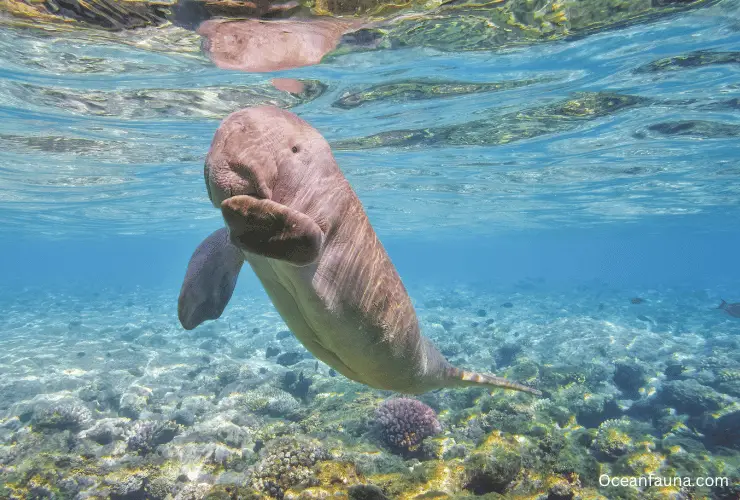
During different seasons, they migrate over large distances. For instance, in Shark Bay, Western Australia, they travel over 600 km in search of food and mates. However, their distribution is highly fragmented due to habitat loss and degradation.
Also Read: Skate Vs Stingray: Differences and Similarities Explained
As primarily marine mammals, they prefer shallow waters of around 10m deep but can dive down to 39m when needed. Their preferred habitats include:
- Protected bays
- Wide mangrove channels
- Sheltered areas of inshore islands
- Tidal sandbanks and estuaries (often used for calving)
- Deeper water where the continental shelf is broad, neritic, and sheltered.
These areas usually feature abundant seagrasses, their primary food source. They also inhabit lekking areas during mating season. Unlike manatees, dugongs predominantly dwell in marine environments.
Manatee
Conversely, manatees are found in the shallow, marshy coastal areas and rivers of the Caribbean Sea, the Gulf of Mexico, the Amazon Basin, and West Africa.
Manatees live in brackish waters to freshwater. All three species have a distinct range.
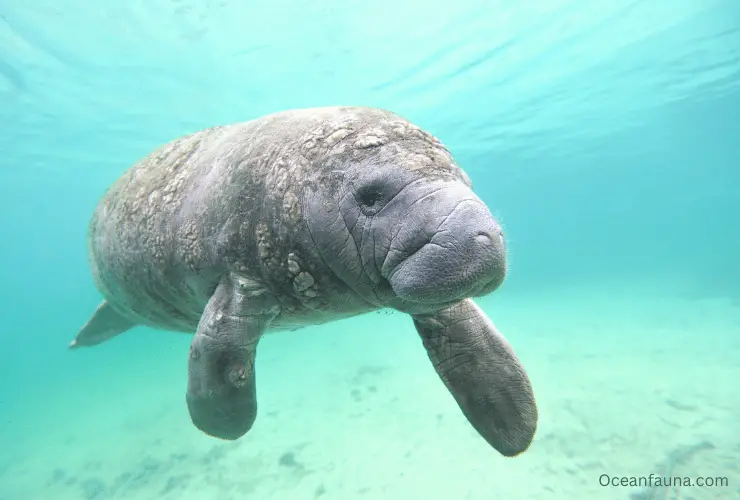
- The West Indian manatee inhabits North and Central America’s coastal waters
- The African manatee ranges along the west coast of Africa, from Senegal to Angola.
- The Amazonian manatee is unique as it’s entirely freshwater and is found in the Amazon River and its tributaries.
Their preferred habitats include
- Oceans
- Lakes
- Rivers
- Reservoirs
- Bays on the coast.
- Coastal Estuaries
- Lagoons
These gentle sea cows, unlike dugongs, are also known to withstand changes in water salinity and can move between freshwater and saltwater habitats. ~ Source
Here’s a quick comparison:
| Aspect | Dugong | Manatee |
| Habitat | Tropical waters of the Indo-Pacific region; residing in almost 48 countries | Shallow, marshy coastal areas and rivers of the Caribbean Sea, the Gulf of Mexico, the Amazon Basin, and West Africa |
| Migratory Patterns | Long-distance seasonal migrations | Less extensive migrations, often related to temperature changes |
| Habitat Preferences | Areas with seagrass beds | Varies with species, ranges from coastal waters to freshwater habitats |
| Distribution | Fragmented due to habitat loss and degradation | Widely distributed, with varying degrees of fragmentation |
3. Physical Appearance
Despite both being sea cows, these two marine animals have several distinctive physical differences.
Dugong
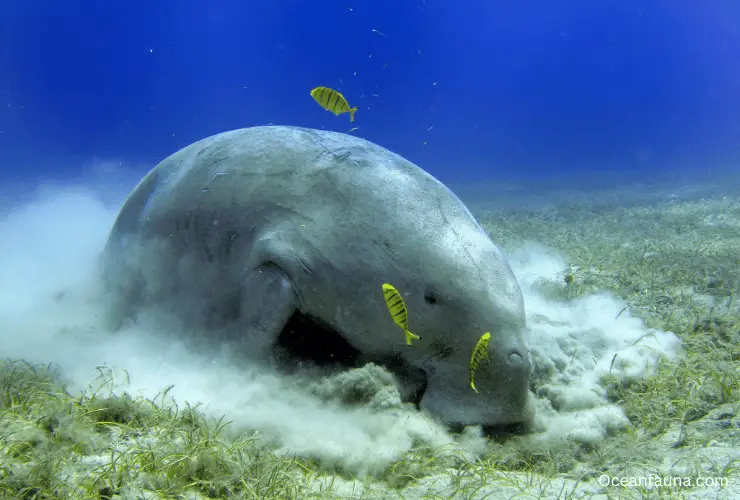
- Body Shape and Size: According to Marine Mammals of the World (Second Edition), 2015, dugongs are large marine mammals with barrel-shaped body that tapers at both ends. They can grow up to 3.3 meters long and at least 570 kilograms.
- Tail: They possess a broad, flat tail, similar to that of a dolphin, and a unique, fluked tail with pointed tips, which they use for propulsion.
- Coloration: The body color of dugongs ranges from gray to brown.
- Skin and hair: Their smooth skin is thick yet sensitive, with sparse, bristle-like hair spread across their body. This hair is especially concentrated around the mouth, which they use to forage for food.
- Snout: The Dugong has a short, broad downturned snout. It has stiff, sensitive bristles that assist them in detecting food.
- Upper lip: The upper lip of the Dugong is heavily cleft and protrudes forward, which aids in feeding from the seafloor.
- Eyes: They have small eyes with a nictitating membrane for protection, but their vision is quite poor.
- Whiskers: Instead, they rely more on their well-developed hearing and vibrissae whiskers on their snouts to find food.
- Flippers: Dugongs have two small, paddle-like flippers without nails. They use their flippers for balance, steering, and walking along the ocean floor.
- Tusks: Dugongs have two incisors, or tusks, which only become visible in males at puberty. On the other hand, the tusks in females continue growing under the skin and may only become visible later in life.
Manatee
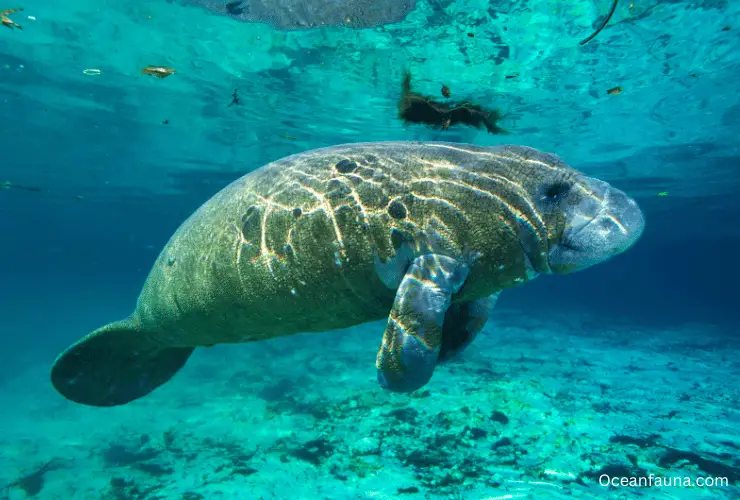
- Body Shaper and Size: Manatees are larger than dugongs, reaching lengths of up to 4 meters and weighing as much as 550 kilograms.
- Tail: Manatees have a rounded tail used for propulsion, which differentiates them from Dugongs.
- Skin and Hair: Like dugongs, manatees have thick, wrinkled skin, mostly grey or grey-brown. They also have body hair and vibrissae but in a lower concentration than dugongs.
- Snout: Manatee has a more rounded, paddle-like snout that faces forward. The snout of the manatee is more flexible and movable. They also have bristles on their snouts, which they use to gather food, just like the Dugong. The Manatee’s snout is a bit longer, and its nostrils are on the upper surface.
- Upper Lip: Manatees have a larger, more flexible upper lip than dugongs, which they use to gather food.
- Eyes: Their eyes are larger than dugongs and equipped with a nictitating membrane for protection.
- Flippers: Manatees also have two forelimbs or flippers with three to four nails used for steering, crawling along the bottom, or manipulating food.
- Teeth: They have a set of marching molars that constantly replace worn teeth throughout their lifetime. Their molars, used for grinding food, continually grow at the back of the jaw and move forward as older teeth wear down and fall out at the front.
Here’s a comparison table summarizing the physical differences between Dugongs and Manatees:
| Physical Features | Dugong | Manatee |
| Size | Up to 3.3 meters | Up to 4 meters |
| Weight | Up to 400 kg | Up to 1500 kg |
| Tail | Dolphin-like with pointed tips, longer (4-5 feet) | Rounded, paddle-like, smaller (2-3 feet) |
| Skin | Grey to brown | Mostly grey or grey-brown |
| Upper Lip | Heavily cleft and protrudes forward | Larger, more flexible |
| Eyes | Small with nictitating membrane | Larger with nictitating membrane |
| Flippers | Small, paddle-like | Larger, with 3-4 nails |
| Tusk | Two tusks; visible in males at puberty, visible in females later in life | No tusks |
4. Diet and Feeding Habits
While both dugongs and manatees are primarily herbivores, their specific dietary choices are influenced by their respective habitats and available food sources. Here we break down the dietary preferences and feeding habits of both of these unique creatures.
Dugong
According to Animal Diversity Web, dugongs are entirely herbivorous marine mammals with a diet solely consisting of seagrass. This underwater vegetation is not only their preferred food choice, but dugongs depend on it for survival. With over 40 seagrass species available in their habitats, dugongs prefer high-nitrogen-content seagrasses.
However, if seagrass is in short supply, they will turn to marine algae as an alternative food source. Additionally, dugongs are thought to diversify their diet with a variety of invertebrates. Creatures like polychaete worms, shellfish, and sea squirts, which inhabit the seagrass, may also be a part of their dietary intake.
A full-grown dugong consumes about 28 to 40 kilograms daily. Dugongs use their downward-facing, bristled snouts and upper lips to dig up entire plants, eating both the leaves and roots. This method of feeding often leaves behind furrowed trails in the seagrass beds.
Manatee
Manatees have a more varied diet than dugongs. Although they primarily feed on a wide variety of submerged, emergent, and floating plants, they occasionally supplement their diet with small amounts of fish and invertebrates.
A manatee can consume about 7% of its body weight in vegetation daily. With flexible lips that aid in grabbing, manatees often only eat the leaves of plants, leaving the roots intact. This feeding behavior contrasts with the dugong’s more destructive feeding habits. ~ Source
| Aspect | Dugong | Manatee |
| Diet | Exclusively seagrass; occasionally polychaete worms, shellfish, and sea squirts | Primarily herbivorous, occasionally eat small amounts of fish and invertebrates |
| Feeding habit | Dig up entire plants, consuming leaves and roots | Usually, eat leaves, leaving the roots intact. |
| Daily consumption | Approximately 28 to 40 kilograms | Approximately 7% of their body weight |
5. Social Behavior
Dugongs and manatees are both sociable creatures, yet their social behavior varies considerably. They interact with their environment and fellow members differently, creating a unique social dynamic in each species.
Dugongs
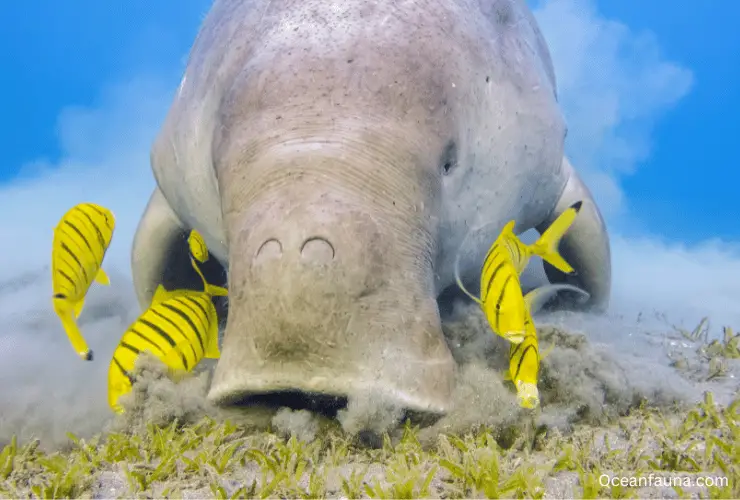
Dugongs are very social animals. They form loose communities that vary in size and structure, with numbers changing according to the season and availability of food. Typically, these groups comprise mother and baby pairs to groups of up to 200 individuals.
Male dugongs are territorial and show aggressive behavior when defending their feeding grounds. During the mating season, males engage in combat, using their tusks to fight for dominance and the right to mate with females.
Interestingly, female dugongs and their calves share a strong bond. Young dugongs remain with their mothers for a period of about 18 months or until the mother becomes pregnant again.
Mother dugongs communicate with their calves using trills, whistles, chirps, or barks, while adults use a combination of sounds, including low-frequency vocalizations, to communicate with each other.
Manatee
According to World Animal Foundation, manatees, unlike dugongs, are solitary. They usually interact with females in estrus.
Male manatees, like their dugong counterparts, are also territorial. They fight with other males for access to females during the mating season. These encounters are characterized by body ramming, pushing, biting, and chasing.
An article published in the Acoustical Society of America suggests that manatees communicate with each other using a range of vocalizations, including squeals, chirps, and squeaks. Mother manatees communicate with their calves using high-pitched sounds, while males emit lower-frequency sounds to attract females during the mating season.
Manatees are known for their playful nature. They often engage in activities like barrel rolling, tail splashing, and body surfing.
| Species | Social Structure | Aggression | Communication | Playful Behaviour |
| Dugong | Social | Territorial males, aggressive during mating season | Uses trills, whistles, chirps, or barks for communication | Less playful |
| Manatee | Solitary | Territorial males, engage in fights for mating rights | Uses squeals, chirps, and squeaks for communication | Known for playful activities like barrel rolling and tail splashing |
6. Reproduction and Lifecycle
Both dugongs and manatees share some similarities in their reproductive behavior and lifecycle. However, they have distinctive features that set them apart.
Dugongs
Dugongs, like other marine mammals, exhibit a slow reproductive rate. Their reproductive biology is fascinating:
- Mating behavior: Dugongs are thought to have a polygamous mating system.
- Mating season: Dugongs typically mate during the spring season. Male dugongs, or bulls, are known to compete with each other to mate with females.
- Gestation period: After mating, the female carries the baby, or calf, for about 13-14 months, with single calf births being the norm.
- Calving: Calving usually occurs in shallow water; the calf is born tail-first. The calf depends on the mother and drinks her milk for 18 months to 2 years.
- Sexual maturity: Female dugongs, or cows, reach sexual maturity between 7-17 years, while males mature around 9-10.
- Lifespan: Dugongs are long-lived animals, often reaching up to 73 years. ~ Source
Manatee
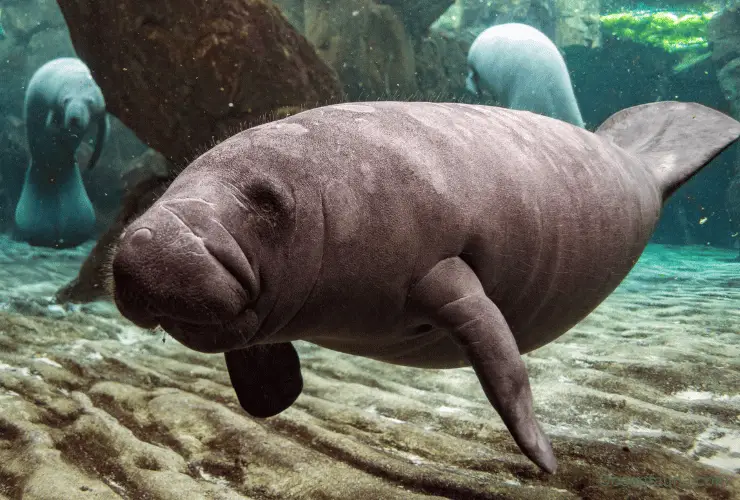
Manatees follow a similar reproductive pattern as the dugongs but have some unique characteristics:
- Mating season: Manatees are polyestrous, meaning they can breed year-round. However, there’s a peak in reproductive activity during warmer months.
- Gestation period: Manatee gestation period is approximately 12-14 months, slightly shorter than dugongs.
- Calving: Similar to dugongs, manatees typically give birth to a single calf, although twins can occur. Calves nurse from their mother for up to 2 years while learning to forage on plants.
- Sexual maturity: Female manatees reach sexual maturity as early as 3 years but typically don’t reproduce until about 6 years. Males mature around 9-10 years.
- Lifespan: Manatees have a similar lifespan as dugongs, reaching up to 60 years in the wild. ~ Source
| Reproduction | Dugongs | Manatees |
| Mating Season | Spring season | Year-round (peak in warmer months) |
| Gestation Period | 13-14 months | 12-14 months |
| Calving | Single calf, nursed for 18 months to 2 years | Single calf (rarely twins), nursed for up to 2 years |
| Sexual Maturity | Females: 7-17 years, Males: 9-10 years | Females: Around 6 years, Males: Around 9 to 10 years |
| Lifespan | Up to 73 years | Up to 60 years |
7. Natural Predators
Dugongs and manatees, due to their impressive bulk and tough skin, have a few natural predators in their environment.
Dugongs
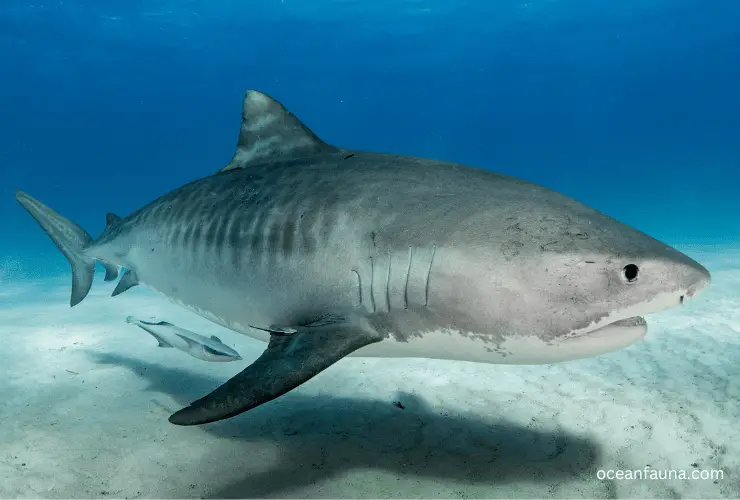
Dugongs, while quite large and capable of defending themselves to some extent, do have a number of predators that they need to be wary of. The most significant of these are sharks, specifically tiger sharks and bull sharks, which are known to prey on dugongs, particularly juveniles or those that are sick or injured. Crocodiles and killer whales have also been reported to attack dugongs on occasion.
Manatee
Manatees, much like dugongs, are preyed upon by several large predators. These include sharks, crocodiles, alligators, jaguars, and, in rare instances, killer whales. As with dugongs, juvenile or sick manatees are more likely to be targeted by these predators.
The table below summarizes the key predators of both dugongs and manatees:
| Species | Natural Predators |
| Dugongs | Sharks (Tiger, Bull), Crocodiles, Killer Whales |
| Manatees | Sharks, Crocodiles, Killer Whales, Alligators, Jaguars |
8. Defense Mechanism
Dugongs and manatees, as gentle and slow-moving creatures, don’t have many ways to defend themselves from predators. Their primary defenses are camouflage, large size, and a sharp sense of hearing to detect approaching threats. Let’s explore each in detail.
Dugongs
Dugongs are graceful swimmers that depend heavily on their environment for defense. Their greyish-brown body coloration enables them to blend into their seagrass habitat effectively, making them difficult to spot by potential predators.
Their eyes are small, but their hearing is incredibly sharp, enabling them to detect the approach of danger. Their best defense is their large size. Juvenile dugongs often stick close to their mothers or stay in herds to protect themselves.
Manatee
Manatees, much like their cousins, the dugongs, rely on their size and hearing for protection. Their size and tough skin help protect them from most potential threats.
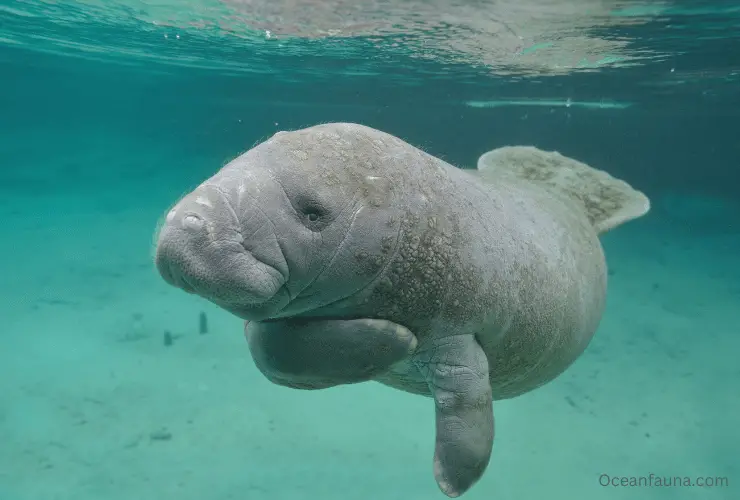
Manatees also have highly developed auditory systems, enabling them to hear approaching danger. This ability to sense threats, combined with their capacity to hold their breath for up to 20 minutes, allows them to stay submerged and undetected when a predator is nearby.
If pursued by a predator, manatees can swim surprisingly fast, reaching up to 20 miles per hour in short bursts. However, manatees prefer to rely on stealth and evasion rather than speed. They often use their environments, such as water plants and muddy river bottoms, as hiding places.
| Defense Mechanism | Dugongs | Manatees |
| Camouflage | Use greyish-brown body coloration to blend into seagrass habitats | Use their environments such as water plants and muddy river bottoms as hiding places |
| Size | Adults can weigh up to 400 kilograms, deterring most predators | Adults can weigh up to 550 kg and grow to be 15 feet long, deterring most predators |
| Sharp hearing | Sharp sense of hearing to detect approaching threats | Highly developed auditory systems, enabling them to hear approaching danger |
| Use of environment | Juvenile dugongs often stay in herds to protect themselves | Will often use their environments, such as water plants and muddy river bottoms, as hiding places |
9. Interactions with Humans
Interactions between humans and these gentle marine mammals, both dugongs and manatees, are quite significant. These interactions, however, often have negative consequences for these vulnerable species.
Dugong
Dugongs are incredibly gentle creatures with a long history with human cultures. They are often associated with mermaid legends.
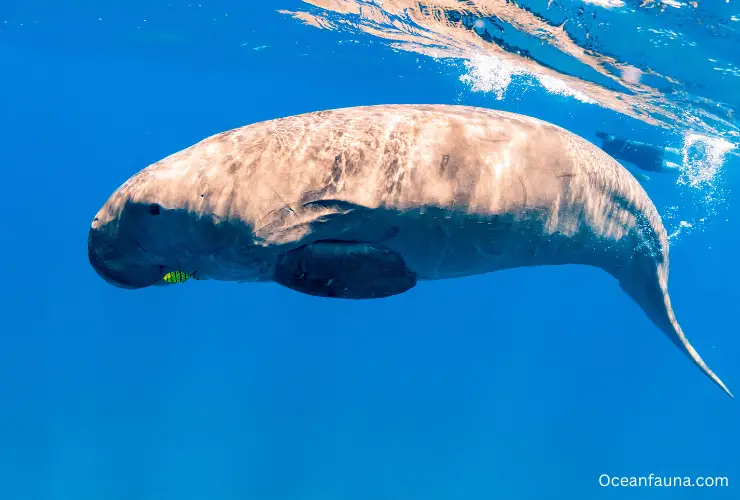
Did you know? There’s intriguing folklore in the Philippines, Malaysia, Indonesia, and Thailand revolving around the dugongs. Many locals in these regions firmly believe that these sea creatures were once human or part-human, often women. They are said to shed tears when they are slaughtered or stranded ashore.
Owing to these beliefs, it’s considered a bad omen if a dugong is unintentionally killed, for instance, in fishing nets or fish pens. Especially in the Philippines, certain regions of Sabah in Malaysia, northern Sulawesi, and the Lesser Sunda Islands of Indonesia. Interestingly, dugongs have traditionally not been hunted for food in these areas and thrived in large numbers until the 1970s.
Regrettably, humans have heavily hunted dugongs for their meat, oil, and skin, especially in Northern Australia and the Pacific Islands. This has led to their numbers drastically declining.
On a more positive note, dugongs are a significant attraction for eco-tourism, especially in countries like Australia. While this can have economic benefits, it is crucial to ensure these activities are carried out responsibly to avoid disturbance to these animals.
Manatee
Manatees are also often associated with mermaid legends and are an integral part of local folklore in many parts of the world.
Like dugongs, manatees are also popular for eco-tourism, attracting tourists for swimming and kayaking activities. While this can generate local revenue, it is essential to regulate these activities to avoid stress or harm to the manatees.
10. Threats and Conservation Status
Like many aquatic species, both dugongs and manatees are experiencing numerous threats that endanger their survival. Both species have similar threats, although the severity of these threats may vary between the two.
Dugong
Dugongs are listed as vulnerable by the IUCN. The primary threats to dugongs include:
- Hunting: According to Dugong Status Report and Action Plans for Countries and Territories, despite international and local protections, illegal hunting for dugong meat and oil still happens. Dugong meat is considered a delicacy in some cultures, and its oil is used for medicinal purposes.
- Habitat loss and degradation: Coastal development, destructive fishing practices, and pollution are causing the loss and degradation of seagrass beds, the primary food source for dugongs.
- Boat strikes: High-speed watercraft pose a significant risk to dugongs, often leading to fatal injuries. ~ Source
- Bycatch: Dugongs are often accidentally caught in fishing nets and die as a result.
- Climate change: Changes in sea temperature can affect seagrass growth, leading to food shortages for dugongs.
Manatee
Manatees are also facing many threats. They are listed as vulnerable by the IUCN. Key threats include
- Boat strikes: According to an article published in Scientific American, manatees are particularly prone to be struck by boats, as they often inhabit shallow waters and are slow-moving creatures. In Florida, for instance, boat collisions are one of the leading causes of manatee deaths.
- Loss of warm-water habitats: Manatees rely on warm-water refuges during the colder months. However, natural warm-water springs are being affected by declining water levels and increasing development.
- Red tide: According to the University of Florida, harmful algal blooms, known as red tide, can cause mass manatee die-offs.
- Pollution and habitat destruction: Historically, humans have hunted manatees for their meat and hide. However, today, the biggest threat to manatees is human activity, including habitat degradation from coastal development and water pollution.
| Aspect | Dugongs | Manatees |
| Conservation Status | Vulnerable (IUCN) | Vulnerable (IUCN) |
| Primary Threats | Hunting, Habitat loss and degradation, Boat strikes, Bycatch, Climate change | Boat strikes, Loss of warm-water habitats, Red tide, Pollution, and habitat destruction |
How Important Are Dugongs and Manatees to the Ecosystem?
Both dugongs and manatees play critical roles in the ecosystems they inhabit. From being gardeners of the sea to contributing to biodiversity, their existence and activities have far-reaching impacts. Let’s dig deeper into their ecological importance.
Dugongs
Dugongs are often called the “gardeners of the sea.” Their primary diet is seagrass, particularly those belonging to the Halodule and Halophila genera. In their search for food, they plow the seafloor, making furrows that are often used by other marine animals for feeding and hiding. Their selective feeding habits also influence the structure and distribution of seagrass meadows.
In fact, dugongs have a significant influence on seagrass biodiversity. By preferentially feeding on certain types of seagrasses, they can change the composition of seagrass communities, thereby influencing the overall biodiversity of their habitat.
Moreover, their feeding habits help recycle nutrients and maintain the health of marine ecosystems. By digging up the seafloor for seagrass, they re-suspend nutrients locked in the sediment, which contributes to nutrient cycling and supports the productivity of the system. ~ Source
Manatees
Manatees, like dugongs, graze on various submerged, emergent, and floating plants, making them important players in controlling aquatic plant growth. By doing so, they help maintain the balance in their freshwater and marine ecosystems.
By eating large amounts of aquatic vegetation, manatees influence the growth, production, and species composition of submerged aquatic vegetation. This not only influences plant communities but also the fauna associated with them.
Moreover, their feeding activity may help to clear channels and canals, improve water flow, and enhance the health of the aquatic environment.
According to an article published in EcoHealth, manatees also serve as indicators of ecosystem health. Because they are sensitive to environmental changes, their population trends can be used to measure environmental conditions.
Frequently Asked Questions
Q: Are Dugongs and Manatee the same?
A: No, dugongs and manatees are not the same. They are different species under the same order Sirenia but belong to different genera. They have various distinctions in terms of their physical attributes, behaviors, habitats, and diets.
Q: How slow are dugongs and manatees?
A: Dugongs and manatees are relatively slow swimmers, typically cruising at around 5 miles per hour (8 kilometers per hour).
Q: Is a manatee a sea cow?
A: Yes, manatees are often called ‘sea cows’ because of their large, rounded bodies and slow, graceful movements. Like cows, they are herbivorous, spending most of their time grazing in shallow waters.
Q: Why are dugongs called mermaids?
A: Dugongs are often called “mermaids” due to age-old maritime folklore. Seafarers and sailors, after months at sea, would occasionally mistake these sea creatures for mythical mermaids because of their human-like upper bodies and fish-like tails.
Final Words
Dugongs and manatees are distinct marine mammals with unique characteristics, behaviors, and roles within their ecosystems. Each has evolved over millions of years to adapt to their specific environments and lifestyles.
Though they have different habitats and distributions, both dugongs and manatees share a love for warm waters and peaceful grazing. Both gentle giants of the sea contribute significantly to maintaining healthy aquatic ecosystems. Unfortunately, they also share the threat of habitat degradation, a key challenge to their survival. It’s up to us, as stewards of our planet, to ensure that they continue to thrive for generations to come.

